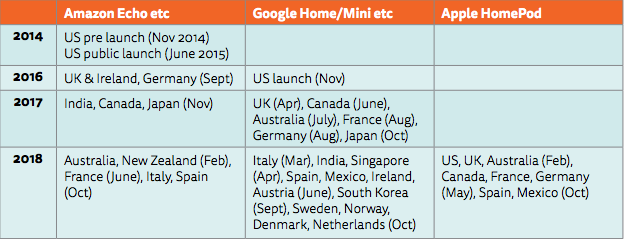|
Getting your Trinity Audio player ready...
|
In our “Business of Audio” series, we have explored topics that have been commonly overlooked in the audio discussion, such as how audio is more than just podcasts and why we cannot forget the monetisation aspect. However there is another topic that does not always get the airtime it deserves: how audio is developing outside of the Anglosphere. Join us as we dive into the status of audio in non-English speaking countries, explore the differences and similarities of these audio initiatives, and highlight innovative audio projects.
Audio expanding in non-English speaking countries
While the Anglosphere is currently debating if we have reached “peak podcast”, other countries are also increasing their podcast usage. A study from Reuters found a wide discrepancy between countries on how many people had accessed a podcast in the last month.

However, the podcasts are not necessarily in the national language — for example, in Turkey many of the most popular podcasts are in English. Indeed, Reuters found that improving English-language fluency is a key motivation for using podcasts in Turkey.
Still, podcasts are not the only way for publishers to experiment with audio, with many publishers working more on audio content for smart speakers as well. We see this in particular growing in Europe, with the Amazon Alexa app recently topping app stores across Europe on Christmas morning, and with Amazon Echo Dots in France, Germany, and Italy temporarily sold out earlier this year. We can only expect the importance of audio to increase as more and more languages and countries are added. One report forecasts a compound annual growth rate of 57%for smart speaker adoption in Europe, leading to 36% of all European homes having a smart speaker by 2021.

Facing many of the same challenges
Just as in English-speaking countries, audio has helped other publishers overcome many of the same challenges, such as reaching a younger audience and developing stronger relationships with subscribers.
Aftenposten, Norway’s largest newspaper (and owned by Schibsted), took a cue from The New York Times and their runaway success with The Daily. In early October 2018, they launched the daily podcast Explained, which gives listeners an in-depth look at one news story, told by Aftenposten’s own journalists. As Norway is a small market, they set a goal of 10,000 daily listeners, which they quickly surpassed and reached 30,000 daily listeners in the first three months. This work paid off for them, with 70% of listeners below the age of 35, meaning they are able to reach a much younger audience than via other digital channels (their average digital subscriber is 40 years old) or print (their average print subscriber is 60 years old). The best part though is the loyalty this product has engendered, with listeners creating a new daily habit. 80% of listeners come back every day, even when there is no promotion for the new content. This aspect of habit formation is something we are particularly interested in at Twipe, and we will be covering how to create such habit forming products at the next Digital Growth Summit in October. Make sure to sign up to receive an invite.
This habit formation aspect of audio is something Belgian daily De Standaard (owned by Mediahuis) has also focused on while creating their podcasts. With two weekly podcasts and a new daily podcast, the team has found that audio has an important novelty:
“You can consume while doing something else. From now on, you can listen to De Standaard while jogging, cooking, ironing, or working. If you are commuting in your car on on the train, you’re free to catch up on your favourite podcasts. This might add time spent on our media, as you’re spending more time with us on occasions where De Standaard traditionally didn’t have the opportunity to break in.” –
Emmanuel Naert, brand manager at De Standaard
We know publishers across the globe are all questioning how they can develop a stronger relationship with their readers. An important first step in this journey is understanding your audience very well. That is why Danish media company Zetlandasked its readers what they wanted more of, and the response was overwhelming — more audio content! They saw a huge increase in listening once they added more audio content, now 60% of their audience listens to content instead of reading.
“Instead of demanding that ‘we like written word so you have to read our stories,’ we try to get a sense of how can we adapt to your world and your way of living.” –
Lea Korsgaard, Zetland editor-in-chief
Room to learn
With non-English speaking countries entering the audio landscape a bit later, at least in terms of smart speakers, there’s room to learn from those that went ahead. As we saw above, smart speakers only came to Spain last year. Carlos de Vega Gonzales, deputy editor of El País, explained to INMA that across Spain many smart speakers were gifted for Christmas, so this year he expects audio to really take off. Spanish publishers are also able to make better use of their audio content, as they are able to learn from what had been done in the US and other countries with early access to smart speakers.
“We are making money, and that’s been very surprising because we’ve been working in video for the last five years, and it’s very difficult to get money for video. During this six months working on audio, even without having a commercial team working on the programme, we already have two or three companies that want to sponsor our content.”
Carlos de Vega Gonzales, deputy editor of El País
There’s also room for new learnings to share with the English-language audio market. For example, German daily Nordwest Zeitung has experimented with what types of content are most successful in audio. Two topics stood out: traffic and obituaries. Traffic updates in audio make sense, a holdover from radio, but the team updated this format: now listeners can have real time traffic updates for their neighbourhood by simply asking Alexa. The importance of obituaries was a more surprising learning, they account for 15% of all audio requests for Nordwest Zeitung. Not all content is created equal, and this is doubly true for audio.
Mary-Katharine Phillips
Media innovation analyst @ Twipe
Republished with kind permission of Twipe Mobile


